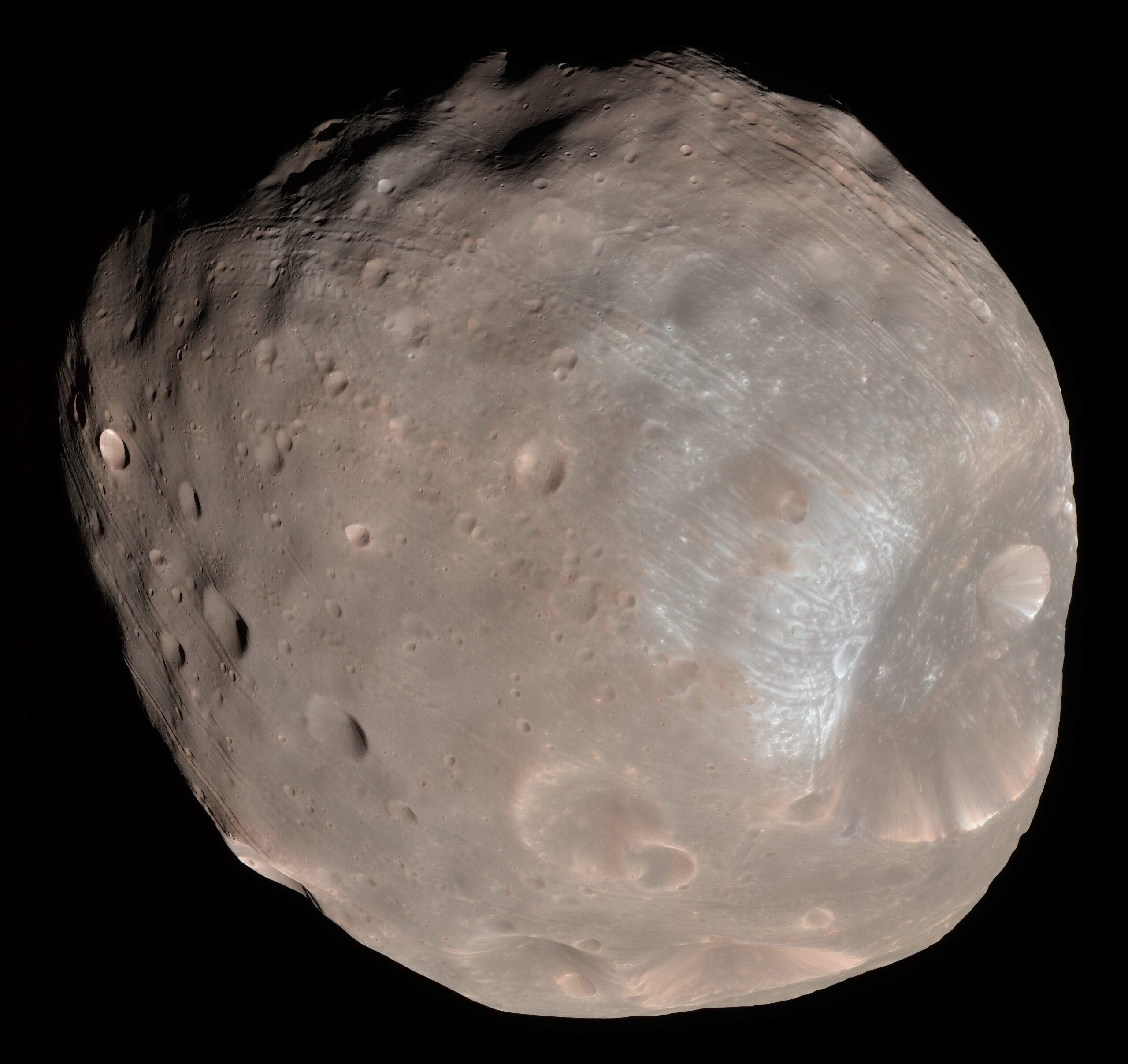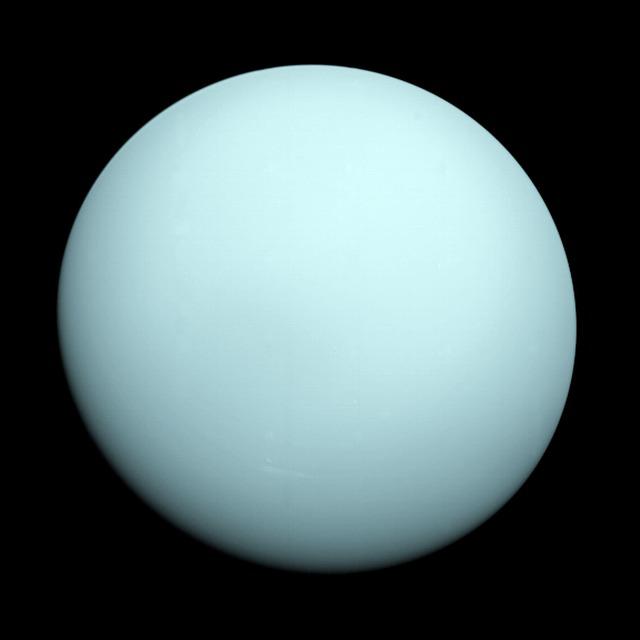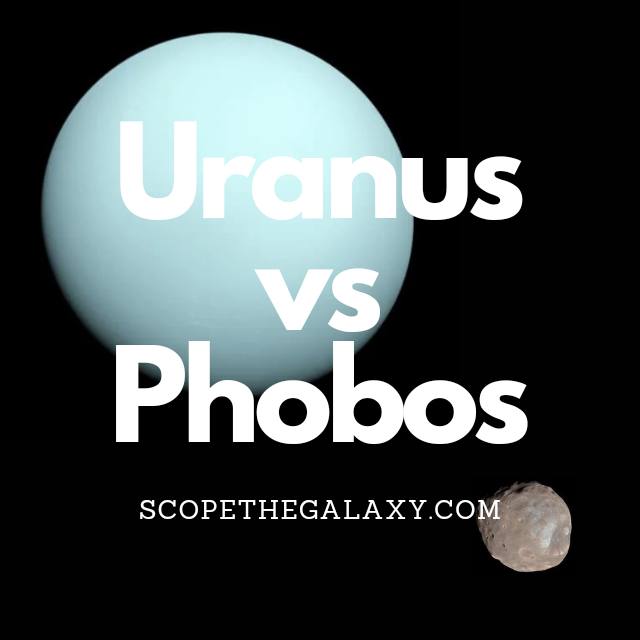*This post may contain affiliate links. This means we may make a commission if you purchase an item using one of our links*
The main differences between Phobos and Uranus are that Phobos is a natural satellite while Uranus is a planet, Uranus has a very drastic axial titl of 98 degrees while Phobos’ is 0 degrees and Uranus is far bigger with a diameter of 50,724km while Phobos’ is 22.53 km.
There are various other differences between the two so, continue reading if you want a more detailed look at each of these bodies along with their similarities and differences below.
What Is The Moon Phobos?
Table of Contents

Phobos is the larger and innermost of the Martian moons, named after the Greek God of fear and panic. This rocky satellite measures approximately 27 x 22 x 18 kilometers and possesses an irregular shape.
Flying only 270 km above Mars’s surface, Phobos orbits the Martian surface so closely that it spins around the planet three times a day (each orbit takes 7 hours and 39 minutes). And this proximity means that the moon cannot always be seen from Mars’ surface (it all depends on where you’re standing).
In general, Phobos rises in the west, passes through the sky in around 4 hours, and sets in the east. And this process occurs twice during one Martian day.
Phobos travels 1.8 m closer to Mars every 100 years, which means this doomed moon will one day crash into its planet or break up into rings. Still, this won’t happen for another 50 million years or so.
The moon is covered in streak patterns from impact craters, the most significant of which is the crater Stickney, with a diameter of 9.7 km. Phobos has weathered thousands of meteorite impacts, one of which almost shattered it to pieces.
It was first discovered by the American astronomer Asaph Hall on 17th August 1877. But, it can be difficult for astronomers to see as it is one of the least reflective bodies in the solar system with an albedo of 0.071.
Despite its small stature, Phobos experiences wildly varying temperatures on its dark side compared to the light side. Measurements on the light side of the moon suggest that temperatures can rise to -4 degrees Celsius, a sort of brisk winter’s day that would be cold but tolerable.
In contrast, temperatures on the dark side can drop to -112 degrees Celsius, even though the two areas are just a few kilometers apart. The probable cause is fine surface dust that cannot retain heat, allowing temperatures to drop rapidly.
The low density of Phobos suggests its composition is similar to carbonaceous chondrite meteorites, which could mean that Phobos is a captured asteroid.
What Is The Moon Uranus?

Uranus is the 7th farthest planet from the Sun and the 3rd largest planet in our solar system, coming in at a diameter of 50,724 km. This means that roughly 63 Earth’s could fit inside this ice giant.
In regards to why this cyan blue planet is referred to as an ice giant, it’s down to it’s composition. Uranus is made mostly of methane, ammonia and water with its atmosphere mostly consisting of hydrogen and helium, much like the Sun, and the other giant planets in our solar system.
Due to its distance from the Sun, it takes Uranus 84 years to complete one orbit our central star, whereas it’s axial rotation is much faster than even our Earth at 17 hours per rotation.
As a result of its distance from the Sun, ice based composition and faster rotation levels, Uranus is far from an ideal place to live in let alone have the potential to support life.
Its base temperature is generally a chilling -190 to -200 degrees Celsius and its rocky core, although hot, is still on the cooler side for a large planet sitting around the 5,000 degrees Celsius range.
The planet’s winds are also very fast often hitting 900 km/h, which is roughly twice that of Earth’s most powerful turbulent wind speeds.
In regards to the moons surrounding this cyan planet, we’ve discovered 27 small ones orbiting it. Furthermore, it has 13 rings surrounding it which also means Uranus has the most abundant collection of rings surrounding in our solar system, which is even more than Saturn.
One of the Uranus’ most unique features would include the manner in which it rotates around its axis. As opposed to the slightly angled rotation that the likes of Earth, Saturn and most other planets display, Uranus’ axis is positioned at a 98 degree angle.
What this means is this ice giant completes an axial rotation on its side as opposed to the relatively up straight positioning of most of the other planets in our solar system.
Similarities Between Phobos And Uranus
There are a few similarities that Uranus and Phobos share, which in this case includes the following:
- Both are part of the same solar system.
- Neither have tectonic plates.
- Both orbit another larger object.
Differences Between Phobos And Uranus
As for the differences between the two, they include the below.
- Phobos orbits Mars whilst Uranus only orbits the Sun.
- Uranus has 13 moons while Phobos has none.
- Uranus is a spherical shape while Phobos is not.
- Uranus is an ice based gas giant planet whilst Phobos is a terrestrial based natural satellite.
- Uranus has a diameter of 50,724km whilst Phobos has a diameter of 22.53km.
- Phobos has no atmosphere whilst Uranus is gas based and therefore, is composed of hydrogen, helium and methane.
- A day on Phobos takes 7 hours 39 minutes whilst a Uranus day is 17 hours.
- It takes Phobos 7 hours 39 minutes to orbit Mars and around the Sun in 687 days whilst Uranus orbits the Sun in 84 years.
- Uranus has an axial tilt of 98 degrees whilst Deimos’ axial tilt is closer to 0.
- Deimos’ temperature ranges between -4 to -112 degrees Celsius whilst Uranus has an average temperature of -190 to -200 degrees Celsius.
- Uranus has 27 moons while Phobos has no moons orbiting it.
- Uranus’ density is 1.27 g/cm³ whilst Phobo’s density is 1.88 g/cm³.
- Uranus’ mass is 8.681 × 10^25 kg whilst Phobos’ mass is 10.6 × 10^15 kg.
- Phobos’ gravitational strength is 0.0057 m/s² whilst Uranus’ is 8.87 m/s².
- Phobos is tidally locked to Mars whilst Uranus is not tidally locked to anything.
- Phobos only orbits Mars 6,000km away and is getting closer to the planet by 1.8 meters every 100 years.
- Uranus has a magnetosphere whilst Phobos has no magnetic field.
Summary
Phobos and Uranus have very few similarities such as the fact both are a part of the same solar system and also orbit a far larger body than themselves.
They definetly are more different than similar whether it be in regards to size, mass, the number of objects that orbit them, the magnetic fields they have and more, so most shouldn’t struggle very much in disntinguishing them from one another.

